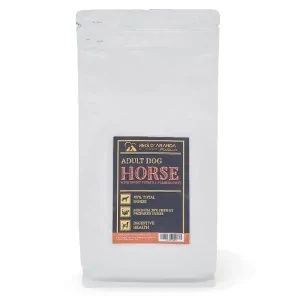Its name says it all: the Vienna blue rabbit comes from Austria. Not only is it beautiful with its shiny blue-grey...
THE GERMAN SHEPHERD DOG
INTRODUCTION
The German Shepherd (German: Deutscher Schäferhund), also known as the German Shepherd, is a breed of medium to large German Shepherd Dog.1 The breed is relatively new, having originated in 1899.2 They are part of the herding group, as they were originally developed for herding and guarding livestock. Since then, however, thanks to their strength, intelligence,3 trainability and obedience, German Shepherds all over the world are often the breed of choice for many other types of work.
THE ORIGIN OF THE GERMAN SHEPHERD
Its origins date back to the late 19th century, when a breeding programme was initiated in Germany to guard and protect the ram herds against wolves. The German army cavalry captain Maximilian von Stephanitz is considered the father of the breed. Later, after the formation of the Association of the Friends of the German Shepherd in 1899, a selection of dogs was started whose crossbreeding improved both the mental and physical aspects of the animal.
The first registered Horand von Grafrath was a vigorous, strong-willed, greyish-coated, wolfish-looking animal who proved to be a stallion with the traits Von Stephanitz was looking for. At the first meeting these desirable traits were passed on to the successor dogs, and reinforced by the careful rules of selective crossbreeding between members of the same lineage of this first breeder; a practice that sought to highlight and enhance desirable traits by means of targeted genetic management.
Von Stephanitz was primarily concerned with the practical and working aspect of the breed. From the outset, the shape of the German Shepherd should not detract from its zootechnical functionality. Von Stephanitz foresaw a first threat to the validity of the breed as a working animal when human society was transformed from a mainly agricultural and livestock basis to an industrialised economy. In a first phase, he persuaded the German government to accept the breed for police work. This was the beginning of the breed's association with law enforcement and military use. Soon the animal's qualities of intelligence, reliability and endurance, the main aspects of its character and its existence in history, ensured its use in many important roles, one of those nobler roles being as a guide dog for the blind.
This breed was used as a tracker dog during World War II by the German army and police. In fact, the services rendered during the two world wars gave it worldwide respect and admiration.
Adolph Hitler was a great admirer of German Shepherds (and animals in general).
After the official establishment of the German Shepherd Club of Germany, with its legal seat in Augsburg, affiliated to the German Kennel Club (VDH), which as the founding association of the breed is responsible for the breed standard for the German Shepherd Dog, drawn up at the first members' meeting in Frankfurt am Main on September 20, 1899 according to the suggestions of A. Meyer and Von Stephanitz, the German Shepherd Club was founded in 1899. Meyer and Von Stephanitz, with the additions agreed upon at the sixth members‘ meeting on 28 July 1901, at the 23rd general meeting on 17 July 1909 in Cologne, at the meeting of executives and councillors in Wiesbaden on 5 September 1930 and at the meeting of the breeders’ committee and the advisory council on 25 March 1961, revised within the framework of the World Union of German Shepherd Dog Associations (WUSV) and approved at the session of the WUSV on 30 August 1976, revised and listed with an authorisation agreement of the executive and advisory council on 23-24 March 1991, amended at the federal assemblies on 25 May 1997 and 31 May/June 2008.
The German Shepherd Dog, whose planned breeding began after the foundation of the association in 1899, has been bred on the basis of the shepherd dogs then existing in central and southern Germany, with the ultimate goal of achieving a working dog with very high performance. In order to achieve this, a breed standard was established for the German Shepherd Dog, which also refers to the body build as well as to the characteristics of the way of being and character.
WHAT IS THE GERMAN SHEPHERD DOG LIKE?
GENERAL APPEARANCE: The German Shepherd Dog is of medium size, slightly elongated, strong and well muscled, with firm bone and firm overall build.
IMPORTANT PROPORTIONS: Height at withers 60-65 cms in males and 55-60 cms in bitches. The length of the torso is approximately 10-17% longer than the withers.
PERSONALITY: The German Shepherd Dog should be balanced, steady of nerve, self-confident, absolutely calm and (except in a nervous situation) good as well as attentive and docile. He must have instinct, endurance and self-confidence to be valid as a companion, guard, protection, police and herding dog.
HEAD: The head is cuneiform, proportionate to the size of the body (length of approximately 40% of the height at withers), not coarse or too elongated, dry in general appearance and moderately broad between the ears. The forehead, when viewed from the front or from the sides, is only slightly arched with little or no marked central furrow.
The proportion between the top of the head and the part of the face is 50/50. The width of the top of the head corresponds approximately to the length of the head. The upper part of the head (seen from above) runs from the ears to the nose in moderate tapering, sliding over a not very marked forehead, reaching the wedge-shaped part of the face (part of the catch). The upper and lower jaw are strongly developed.
The nasal dorsum should be straight, a hollow or arched nose is not desirable. The lips are taut, well closed and dark in colour.
The nose should be black.
The dentition should be strong, sound and complete (42 teeth according to the dental formula). The German Shepherd Dog has a scissor bite, i.e. the incisors must engage in a scissor bite, so that the incisors of the upper jaw coincide like scissors with those of the lower jaw. Defects are the upper, front and back bite, as well as large gaps between the teeth (incompleteness). It is also a defect if the incisors are in a straight line. The jaw bones should be well developed so that the teeth can be embedded in the gums.
The eyes are of medium size, almond-shaped, somewhat slanting and not protruding. Eye colour should be as dark as possible. Light, deep set eyes are not desirable as they detract from the dog's expression.
EARS: The German Shepherd Dog has medium sized, straight ears which should be carried erect and in the same direction (not drooping sideways), ending in a point and with the pinna pointing forwards. Ears which fold or hang down are considered deficient. In movement or at rest, the backward positioning of the ears is not considered a defect.
NECK: The neck should be strong, well muscled and without hanging skin (dewlap). Its slope in relation to the back is about 45%.
BODY: The topline extends without visible interruption from the base of the neck through the high, long withers and straight back to the slightly sloping croup. The back is moderately elongated, firm, strong and well muscled. The loin is broad, short, strongly developed and well muscled. The croup should be long and slightly sloping (approx. 23° to the horizontal line) and reach the root of the tail without interruption of the topline.
The chest should be moderately broad, the underside of the chest preferably long and accentuated. The depth of the brisket should be approximately 45-48% of the height at the withers.
The ribs should be moderately sprung; a barrel chest, as well as ribs which are too flat, is considered a fault.
The tail should reach at least to the hock, but not more than halfway to the metatarsus. The underside of the tail is slightly longer and should be carried hanging gently towards the ground, but in moments of excitement or movement it should be carried more strongly raised, but not above the horizontal line. Any corrective operation is forbidden.
LIMBS:
FOREQUARTERS: The forelegs must be seen to be straight from all angles, from the front they must be seen to be absolutely parallel. The scapula and humerus are of equal length and must be firmly attached to the torso by strong musculature. Ideally, the shoulder blade and humerus should form an angle of 90°, usually up to 110°.
The hocks should not be twisted outwards in either the resting or moving position, nor should they be tucked inwards. The forearms should be straight from all angles and completely parallel to each other, dry and well muscled. The metatarsus is about 1/3 of the forearm and forms an angle of about 20-22° to the forearm. Both a too steep metatarsal (more than 22°) and a stiff metatarsal (less than 20°) are detrimental to functional ability, especially endurance.
The legs are rounded, well closed and arched, the soles hard but not rough. The nails are hard and dark in colour.
HINDQUARTERS: The position of the hindquarters is slightly rearward, but when viewed from the front, the hindquarters are parallel to each other. The femur and tibia are of about equal length and form an angle of about 120°, the thighs are strong and well muscled.
The hocks are strongly developed and firm, the hind pastern is placed vertically under the hock.
The legs are closed, slightly arched, the soles stiff and dark in colour, the nails strong, arched and also dark in colour.
GAIT / MOVEMENT: The German Shepherd Dog is a trotter. The length and angulation of the limbs should be synchronised in such a way that, without altering the topline too much, the dog can move the hindquarters towards the torso and cover the same distance with the front legs. Any tendency to over-angulate the hindquarters reduces the resistance and thus the working ability of the dog. When the proportions of structure and angulation are correct, the result is a propulsion which allows the dog to cover space and move flat on the ground, and gives the impression of effortless forward movement. With the head inclined forward and the tail slightly raised, in a regular and quiet trot, a smoothly curving, unbroken line is formed from the tip of the ears, through the nape of the neck and back, to the tip of the tail.
SKIN: The skin adheres (smoothly) but without wrinkling.
COAT:
COAT CHARACTERISTICS: The German Shepherd Dog will be bred in short and long haired varieties, both with undercoat.
- SHORT HAIR: The outer coat should be as thick, harsh and dense as possible. On the head, including the inside of the ears and on the front part of the limbs, on legs and toes, the coat is short, somewhat longer and stronger on the neck. On the back of the limbs, the coat is long up to the front tarsus or hock, on the back of the thighs moderate breeches are formed.
- LONG HAIR: The outer coat should be long, soft and not too dense, with tufts on ears and limbs, thick breeches and thick tail with downward tufting. On the head, including the inside of the ears and on the front of the limbs, on paws and toes, the coat is short, somewhat longer and stronger on the neck, forming almost a mane. On the back of the limbs, the hair extends to the front tarsus or hock, forming noticeable breeches on the back of the thighs.
COLOURS:
- Black with reddish-brown, brown, yellow to light grey patches.
- Completely black.
- Grey with darker shadings, the coat and mask are black.
Small, discreet white patches on chest and very light underparts are permissible but not desirable. The nose should always be black. Lack of mask, clear and piercing eye colour, as well as clear, almost white patches on chest and inner parts. Light claws and red tail tip are to be considered as lack of pigmentation. The undercoat is slightly greyish. White is not permitted.
SIZE AND WEIGHT:
MALES:
- HEIGHT: 60-65 cm
- WEIGHT: 30-40 kg
FEMALES:
- HEIGHT: 55-60 cm
- WEIGHT: 22-32 kg.
N.B.: Males should show two visible testicles with normal development which are completely located in the scrotum.
DEFECTS:
Any deviation from the above points is to be considered as a fault, the assessment of which should be in fair proportion to the deviation.
SERIOUS FAULTS:
Any deviation from the characteristics described above which impairs the working ability of the dog.
- EAR DEFECTS: Ears set too low and tilted to one side, drooping ears, converging ears, loose ears.
- Severe lack of pigmentation.
- General firmness severely affected.
- TOOTH DEFECTS: All deviations of the scissor bite and of the shape of the teeth, even if not an exclusionary defect (see following).
EXCLUSIONARY FAULTS:
- Weak-natured, aggressive and biting dogs.
- Dogs with proven severe HD (dysplasia).
- Monorchids and cryptorchids as well as dogs with visibly disparate or atrophied testicles.
- Dogs with severe ear and tail defects.
- Dogs with malformations.
- Dogs with dental defects when missing:
1 premolar 3 and 1 other tooth
1 tusk
1 premolar 4
1 molar 1 or 1 molar 2
3 or more teeth. - Dogs with jaw deficiency:
Closure of the mouth with separation between upper and lower incisors greater than 2 mm.
Forward bite (Prognathism).
Pincer bite in the total incisor area. - Dogs over or undersized by more than one centimetre.
- Albinism
- White coat colour (also with dark eyes and nails).
- Semi-long coat without undercoat.
- Long coat (long, soft outer coat without undercoat, in most cases forming a central stripe on the back, tufts on the ears, limbs and tail).
THE HEALTH OF THE GERMAN SHEPHERD
Due to its popularity the health of the German Shepherd has declined over the years, but this does not mean that the breed is unhealthy, as a careful bloodline and crosses made on the basis of health and timely health tests can ensure that our German Shepherd will have an average life expectancy of about 12 years. Diet and exercise in this breed are essential, and some of the health tests (with the exception of stomach torsion) are as follows:
- HIP DISPLASIA: This is a very common disease in German Shepherds. It is characterised by inflammation and pain in the joint between the hip and the femur of the dog. It is a congenital hereditary disease.
- GLAUCOMA: This hereditary disease is detected at the age of 2 or 3 years. The German Shepherd's eye hurts and he rubs it with his paw or against a surface. The intraocular pressure increases and causes the pain. The opaque and dilated pupil is a clear symptom of the disease.
- KERATITIS: Keratitis is an inflation of the cornea, the transparent portion of the eye, which in the German Shepherd has a characteristic corneal inflammation called pannus. It occurs when the patient's immune system mistakenly fights against the ocular structures themselves.
- STOMACH TORSION: Acute dilatation of the stomach due to accumulation of gas, which collapses the circulatory system.
- ELBOW DYSPLASIA: Canine elbow dysplasia is a disease consisting of multiple abnormalities of the elbow joint. The elbow joint is a complex joint consisting of three bones (radius, ulna and humerus) (figure 1). If these three bones do not fit together perfectly as a result of growth faltering, an abnormal weight distribution over different areas of the joint occurs, causing pain, lameness and leading to the development of arthritis. Elbow dysplasia is a disease comprising several disorders grouped into medial space disease (fragmentation of the coronoid process, osteochondrosis, elbow incongruity and elbow anomalies) and nonunion of the anconeal process. The cause of canine elbow dysplasia is unclear. There are several theories as to the exact cause of the disease, including genetics', cartilage growth defects, trauma, diet and other issues. The most common suspicion is that it is a multifactorial disease causing growth disturbances.
In terms of nutrition, the German Shepherd is a sporting dog that requires quality protein, essential fatty oils (Omega 3) and condoprotective supplements to be in optimum condition. Good examples of quality food are Reis d'Aranda's salmon feed for puppies and Reis d'Aranda's horsemeat feed for adult dogs.
As far as grooming is concerned, daily brushings are essential (especially during the moulting season) and baths are recommended every three months.
THE VERSATILITY OF THE GERMAN SHEPHERD
We all know that the German Shepherd is a very versatile breed capable of different activities, but without a doubt its best ability is attack and defence.
CONCLUSION
The German Shepherd is a fantastic breed but it requires a lot of work on the part of its owners, it must be given exercise and strict (but not rough) training and a lot of socialisation with all kinds of people and animals to prevent it from causing problems in adulthood that can cause sleep deprivation.
Leave a comment
Log in to post comments
















